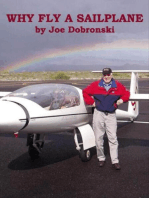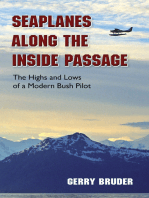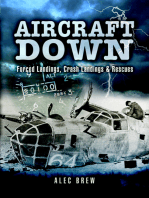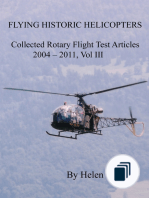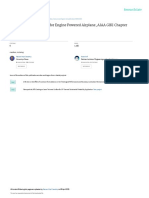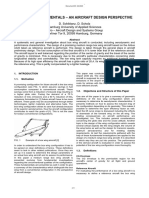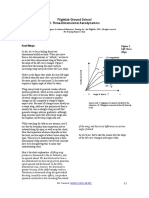Wearable Wings
Wearable Wings
Uploaded by
Denny ReidCopyright:
Available Formats
Wearable Wings
Wearable Wings
Uploaded by
Denny ReidOriginal Description:
Copyright
Available Formats
Share this document
Did you find this document useful?
Is this content inappropriate?
Copyright:
Available Formats
Wearable Wings
Wearable Wings
Uploaded by
Denny ReidCopyright:
Available Formats
Can a Human Fly Like a Bird?
D.Reid
PO Box 143 Oneroa, Waiheke Island, AUCKLAND 1840, New Zealand
Email: wearablewings@gmail.com, www.wearablewings.ning.com
OVERVIEW
Is it possible to fly like a bird, with wings that fold into a backpack? This paper looks at the possibility of creating personal
wings with sufficient performance to soar in most daytime weather conditions and concludes that this goal is indeed possible.
I describe the approach I have taken towards realising the dream of wearable folding wings for soaring flight. For good
penetration into headwinds and to fly between thermals, a lift to drag ratio of at least 30:1 is desirable. The threshold sinking
speed for unlimited soaring ability is about 0.3 m/s and at least 0.4 m/s is achievable with wearable folding wings.
LIMITATIONS OF EXISTING DESIGNS STABILITY
Hang-gliders and parafoils are the closest examples to Finding performance possibilities has little future unless
wearable wings. Hang-gliders tend to suffer from poor lift the resulting wings are stable in flight. This topic has long
distribution and high profile drag due to exposed wires and interested the author who has been fascinated by tailless
struts. Parafoils have very high profile drag due to numerous aircraft designs. These were always limited by the need
suspension lines and exposed pilot position. transfer tailplane function to the wing with consequent loss of
Increasing the performance of gliders demands drag efficiency. Thus the benefits of a tailless configuration were
reduction. For a sailplane to climb it has to have a sinking lost by the requirements for a larger wing.
speed less than the speed of rising air currents. To fly long On the way to New Zealand from Germany to design a new
distances it must fly fast with low sinking speed. Combining competition sailplane for the New Zealand Gliding Federation
the two requirements requires reduction in both induced and I was able to observe albatrosses soaring behind the ship. It
profile drags. Induced drag can be reduced through optimum was clear from their relaxed flight style that the birds were
lift distribution and increased wing span. Artificial wing tip very stable in spite of their near tailless configuration. I was
feathers can also substantially reduce induced drag. Profile determined to unlock nature’s stability riddle.
drag can be reduced by improved streamlining and surface
I felt there must be a spring element involved yet experiments
area reduction.
showed that there must be another factor. Flight muscle
elasticity spring is the spring and to be effective there had to
EXPERIMENTS DEMONSTRATING POSSIBILITIES
be a feedback element which compared wing lift with muscle
A project in New Zealand involving Waikato University,
tension. The missing aspect was discovered by Dr. A.D.
the Waikato Technical Institute and Auckland University
Sneyd of Waikato University whose mathematical analysis
demonstrated a wing that met the above performance
showed that the spring had to have a reverse gradient.
requirements. This was a membrane wing of 15 metre span
Looking again at bird anatomy, nature had achieved this
and an aspect ratio of 27 and was mounted on a framework
through the deltoid crest on the humerus.
attached to a bus. Load cells measured lift, drag and pitching
moment. Test results showed a best L/D of 50 at 18 m/s The simple geometry of the deltoid crest provided the key
which translates to a sinking speed of 0.3 m/s. The sail was to achieving pitch stability on an efficient cambered wing.
seamless and the internal kaugis did not touch the membrane, All birds, bats and pterosaurs exhibit this geometry. This
resulting in a very fair aerofoil contour for minimum drag. enables a mechanical feedback system that maintains a
. state of unstable equilibrium. I presented this theory as “The
Principles of the Constant ‘g’ Stability System” at CEAS2007.
Testing a Dereidactyl Wing
experiments at Hamilton Airport sponsored by NZ TV
WEARABLE FOLDING WINGS
Combining all the successful elements makes wearable
folding wings possible. Making membrane wings that fold is
not so difficult. Creating folding wings that tension themselves
via lift forces to achieve an efficient aerofoil shape is more of a
challenge. Making them fold easily and compactly is difficult
and allowing the flyer to extend and furl the wings at will is a
further test of ingenuity.
There is great potential to incorporate retractable artificial
This was a very simple wing with no control system. While wing tip feathers. Once optimised, the maximum L/D could
sweep forward and a flexible structure gave it static stability, rise to 40 and minimum sink reduce to 0.35 m/s. Thanks
it did not have the dynamic stability from a reverse gradient to a donation of some carbon fibre windsurfer masts, the
balance spring. structural weight will be reduced to perhaps 10 kg, a low
value for a complete aircraft high performance sailplane.
Dereidactyl Specifications CONCLUSIONS
wing span 15 m It is both possible and practical to design and build high
wing area 8.3 m2 performance wearable folding wings which enable a flyer to
exploit microlift and thus enjoy extended soaring throughout
aspect ratio 27 the year. This will greatly increase the opportunities for
weight 18 kg enthusiasts to enjoy the sport of soaring at a much reduced
gross weight 80 kg coat with enhanced convenience.
Can a Human Fly Like a Bird? Page 1
INTRODUCTION TO PERFORMANCE hang-glider, microlift glider, Dereidactyl wing, and Wearable
Wing are compared. My Dereidactyl wing shows the best
In considering the possibility of a human flying like a bird, it is
performance. This wing never reached a man carrying
useful to consider what sort of gliding ability is necessary for
state yet its measured performance shows the potential for
reliable soaring. Humans are not strong enough to sustain
development.
flight through physical effort hence the ability to extract
energy from the atmosphere is needed. There is always The design of wearable folding wings demanded a size that
some movement in the atmosphere. A glider gains energy could be folded into a backpack. Thus the long, narrow
from gravity, sliding down a glide-path. To avoid reaching the Dereidactyl configuration could not be considered. Nature
ground it must find air rising faster than its descent speed. uses finger-like wing tip feathers to disperse wing tip vortices
Thus the lower the descent speed the greater the chance to in three dimensions. Emulating these was aided by excellent
stay aloft. research by the Swiss engineer, LaRoche and his WingGrid.
It is not only performance that is important; pilot safety is vital.
Hang-gliders and parafoils can only fly in conditions of strong
The most dangerous phase of flying is landing. For a pilot to
lift. The same applies to most soaring birds where the larger
land on his feet, his approach speed must be slow resulting in
species can live only where these conditions prevail. Recently
the danger of an abrupt wing tip stall and injury. The wing tip
gliders have been designed to utilise weak lift and are called
feathers greatly reduce this hazard.
microlift gliders. On the chart below, a falcon, parafoil,
The above graph compares sinking speeds of a peregrine falcon, paraglider, hang glider, Archaeopteryx glider and Wearable
Wings. The calculated performance of wearable wings with tip feathers extended is almost identical to the Archaeopteryx. With
tip feathers retracted, the weratble wings show much better penetration.
MINIMUM PERFORMANCE REQUIREMENTS CROSS COUNTRY FLYING
Gliders design to utilise microlift are able to soar in weak Flying accross country involves two basic elements. The first
lift and so extend opportunities for reliable flight. Can a is circling in thermals to gain altitude. The second is straight
wearable wing glider be designed and built with this kind of line flying between thermals.
performance?
During cIrcling flight, the wing operates at a high lift coefficient
To further the wearable folding wing project I developed and at g > 1. A typical circling radius involver g ~ 1.2.
a spreadsheet to explore the range of possibilities. As
described in my CEAS2007 paper, “The Principles of the During this phase the ideal wing will have high camber and
Constant ‘g’ Stability System”, the spreadsheet can receive no twist. The wing-tip feathers will be fully extended and
a wide variety of inputs and calculate stability, stresses and fanned.
performance. For high speed inter-thermal flying, the wing-tip feathers
MICROLIFT SOARING ABILITY PREDICTED will be retracted and membrane tensioned held as high as
The calculations, using drag coefficients dereived from the possible. Here, minimum profile drag and surface want to be
Dereidactyl experments, demonstrate the potential to create at a minimum. A streamlined pilot enclosure is important for
folding wearable wings able to soar in microlift conditions. this high speed flight with minimum loss of altitude.
Can a Human Fly Like a Bird? Page 2
WING FOLDING
Folding wings are the norm in nature. Creating high performance soaring wings that fold into a backpack is a challenge not yet
realised. In this section will look at attempts to create a practical configuration that is light, compact, workable and reliable.
The wing plan shown above is the configuration of 1 september 2009. Here the wing spars are made from windsurfer masts.
The wing tip feathers are formed from polypropylene foam with bamboo shafts. The kaugis are foam with carbon fibre caps.
The photos of the FOLDED WING CARBON WING, FEATHERS RETRACTED
folded wing are of
an early version of
the wing without
feathered tips, Jan.
2009. The drawings
show my latest ideas
for kaugi positions.
FOLDED SIZE
How compact should the the folded wings be? I wanted With a folding wing, the spar stiffness cannot be used to brace
wings that could be carried on a bus, worn as a backpack the wing. Instead lift forces can be used combined with a
on a bicycle and easily permit walking through doorways. leading edge tendon also found in nature. This pteroid tendon
Limiting joints to three per side and having retractable wing tip supports the wing leading edge and provides the counter-
feathers permits a full span of 8 metres with a folded height of force to balance membrane tension.
1.2 metres when worn as a backpack. Further sail tension comes from internal kaugis. Since sail
tension needs to increase with speed, these kaugis must
WING HINGE CONSTRAINTS have adjustable length. This length is set by the pilot’s speed
control.
Compact folding wings require joints that fold through almost
180 degrees so that spar tubes lie parallel when the wing is The wing tip kaugis is designed to take bending loads, unlike
folded. The hinges must resist both bending and torsion. the simpler Dereidactyl wing. This avoids high torsional loads
on the hand spar with its wide bracket making room for the
three sets of kaugi.
STRUCTURAL STRENGTH
Each spar element must have sufficient strength to sustain
bending and torsion loads over the complete flight envelope
with an adequate safety margin. Thanks to inherent bending
relief and the feedback stability system, flight loads are
limited to pilot manoeuvres. The stability system limits
imposed loads to defined values. Thus neither gusts nor
piloting can induce excessive flight loads.
THREE DIMENSIONAL GEOMETRY
In flight the wing spar is curved in three dimensions yet when MAJOR STRUCTURAL COMPONENTS
folded need to lie compactly. This is achieved by adjusting
hinge axes.
TENSIONING THE WING
A membrane or sail wing has to be under tension to nylon feather sheath
function. On boat sails the wind force inflates the sail.
This ceases to be effective at low angles of attack;
the sail begins to luff and loses its designed shape. carbon hand spar
This is particularly serious for glider wings since at high
speed they fly at low angles of attack. Two solutions
to this problem include ribs or battens to retain sail carbon forearm spar
shape or tension applied to the fabric. The 15 metre
span Dereidactyl wing had 7 internal struts called backpack frame
“kaugis” plus a trailing edge wire tensioned to 30kg. carbon upper arm
Can a Human Fly Like a Bird? Page 3
STRUCTURE WING STRUCTURE PARTLY FOLDED
For my first attempt, I decided to emulate nature and fashion
the wing spar in terms of upper arm, forearm, hand and fingers.
The shoulder joint is pin jointed and able to transfer bending
loads accross the structure.
FOLDED WING AS A BACK PACK
The photo on the left shows the
complete wing folded on to an
aluminium pack frame. For flight the
pilot is supported by the frame by a
series of straps, not shown here.
This was the focus of the project,
to have the backpack wing unfold
into a high performance sailplane SHOULDER JOINT drag
enabling a person to fly like a bird. GEOMETRY resultant lift
To become operational, the pilot
needs a streamlined envelope and centre spar
helmet.
SHOULDER JOINT & PTEROID
The shoulder joint is pin
jounted, the upper arm balance moment ang
connecting a centre Mb = Mb * tan[angle] le o
f at
tac
tube. This tube can be k
pilot rotated for speed shoulder pivot
adjustment. The pteroid
tendon geometry is the The shoulder pin transfers most of the flying loads to the
basis for pitch stability. centre spar. The remainder is resisted by the stability
balance spring. This proportion varies with the angle of
ELBOW PIN JOINT attack of the wing.
The elbow joint is offset
to permit the spar tubes SHOULDER FROM UNDERSIDE SHOWING
to fold against each REVERSE GRADIENT SPRING GEOMETRY
other. The hinge pin is
angled so that the ex-
tended spars form an
arch matching the wing trailing edge shape. This hinge has to
support both bending and torsion and the present arrangement
is more mock-up than engineering.
WRIST JOINT, PTEROID STRUT & PTEROID TENDON
feather sheath
forearm
hand
PACKFRAME, WING STRUCTURE AND SAIL WING FROM PORT AFT QUARTER, JANUARY 2009
Can a Human Fly Like a Bird? Page 4
STABILITY and restoring lost lift. Compensating wing twist is helpful to
maintain lift if angle of attack is reduced without involving high
In order to achieve maximum performance, the wearable
inertia pilot rotation. The wing must actually develop more lift
wings’s efficiency and surface area needs to be minimised.
than weight since the initial lift loss means some altitude is lost
Using Nature’s Constant ‘g’ Stability System allows stable
as well. This is why to reverse gradient spring is essential to
flight without a tail. Constant ‘g’ Stability is a mechanical
achieve dynamic stability.
feedback system that maintains a state of unstable equilibrium
by balancing wing lift against spring tension. HOW THE SYSTEM SEEKS EQUILIBRIUM
To ensure longitudinal stability, basic principles must be Constant ‘g’ stability is an active feedback system which
followed. The system balances spring tension against a lift maintains a state of unstable equilibrium. It is a mechanical
dependent factor. Only in this way can the system detect equivalent to modern ‘fly by wire’ used in military aircraft. The
changes in ‘g’ forces. In other words, pitch stability is based stability system involves two unstable elements which combine
on measuring vertical acceleration changes. to form a stable one. The first one is an unstable cambered wing
THE NECESSITY OF A NEGATIVE SPRING RATE and the second is a reverse gradient balance spring.
A factor that is perhaps the hardest to grasp is the need for the An unstable wing cannot be made stable by itself unless there
balance spring to have a negative spring rate. The system is in is some means to create an aerodynamic correcting moment.
equilibrium when spring tension balances a defined lift moment. This can take the form of inducing twist, sweep and or camber
If the wing loses altitude then extra lift is required to regain change. The reverse gradient spring has no stable balance
lost altitude; however, a lift decrease results in reduced spring point. If the wing alters its pitching moment with lift changes to
tension. This contrdiction is resolved through a negative spring produce a restoring moment, the reverse gradient spring allows
rate. Before flying, the spring moment is at a maximum
HOW GEOMETRY MUST CHANGE WITH LIFT and spring tension is lowest. There is only one
Lift changes must be accompanied by changes in wing twist point where balance is achieved.
and sweep that produce a restoring moment, a negative pitch down
feedback mechanism. These effects must be compatable
with wing folding and must resolve inherent conflicts. pivot L=W
SYSTEM BALANCE
For the system to work, spring tension extends the wing while
lift forces fold the wing. At equilibrium, balance occurs when pitch up
g
lift equals weight. The pilot’s manoeuvre control adjusts this rin
sp
balance setting. FINDING EQUILIBRIUM
CONFIGURATION IN NATURE with a wing reverse gradient
In nature, two mechanisms operate together: spring system
1. The flight muscle acts between the deltoid crest on the There is only one point
humerus and the breastbone. The elasticity of the flight where net moments
muscle is the balance spring. Lifting loads cause the humerus sta are zero and this is
to lift up and rotate, the to a lower incidence. A lift decrease + ble the lift about which the
sta trim
causes dihedral to decrease and incidence to increase. M bili system is stable.
tys
2. When flying, lifting forces have to keep the wing extended lop
e
so that the creature does not have to waste energy. This is lift effect
achieved by angling hinge axes so that lift forces extend the
wing. 0
SUMMARY OF STABILITY PRINCIPLES
1. Balance spring acts between humerus deltoid crest and body. - effect of wing camber
2. Spring gradient is reversed by humerus geometry.
(effective only through a narrow angular range)
3. Degree of stability depends on the restoring moment per g.
STABILITY AND THE WEARABLE FOLDING WING balance spring
Unlike nature, I designed the upper arm soar to have a pin joint
instead of a ball joint. This eliminates the option of spar twist
with lift change and so creating a restoring moment requires a
different mechanism. A lift increase causes the upper arm to
increase its sweep angle. This sweeps the wing back and also
reduces spanwise tension producing a correcting pitch down
moment.
INERTIA AND THE SPEED OF CORRECTION
The stability system maintains a state of unstable equilibrium
and low pitching inertia and quick correction are important ACHIEVING THEORY IN PRACTISE
aspects. The first component to move is the humerus since it In creating wearable folding wings it is important to keep
is directly connected to the spring. theory constantly in mind since it is all too easy to design
For example, with a lift reduction, the humerus will swing forward non-viable mechanisms. The trickiest aspect has been the
forcing the forarm out, tensioning the wing, increasing tension reverse gradient spring mechanism.
Can a Human Fly Like a Bird? Page 5
DIRECTIONAL STABILITY CONTROL
Neither birds, bats or pterosaurs have vertical tails. Directional Constant ‘g’ stability is a mechanical feedback system. Pilot
stability relies on wing planform. The picture on the left shows control is via adjusting the parameters of the system rather
three bird planforms which achieve than direct control movement. For example, the system is
directional stability in different ways. stable about a single airspeed for a given g setting. To fly
The frigate bird at the top has its inner at a different speed, the pilot changes the wing camber. To
wing swept forward with dihedral manoeuvre and fly at a different g setting, the pilot adjusts
and its outer wing swept back with the effective balance spring tension. Directional and lateral
anhedral. The pelican in the middle control involve differential adjustment.
has a similar planform except for A person wearing backpack wings has only two hands for
splayed wing tip feathers. The eagle control. For optimum streamlining, the pilots arms and
below has a slightly swept forward hands must be contained within the wing’s contour except for
wing with dihedral. Below, the condor protruding head and feet.
and pelican illustrate the consistancy
within nature. I concluded that the best position would be with hands by
hips, the control levers extending from the backpack towards
the pilot’s front. Control options include levers moving fore
and aft, side to side, twist grips and brake type levers. In
longitudinal flight, the pilot needs to control manoeuvre and
speed. With my wearable wings, the shoulder hinge pins
resist most of the wing bending loads. Spring tension resists
the residual loads. For manoeuvre, rotating the centre spar
alters the ratio of air loads between hinge pin and balance
spring and so alter’s the wing’s equilibrium point.
TRIM SPEED
The royal albatross shows the Flight speed is determined by adjusting another equilibrium
typical sea bird planform with its point. Feedback always seeks a zero moment balance
swept back wing tips point where lift moments balance camber induced pitching
The gull and fruit moments. In level flight, lift moments are constant and
bats have similar camber moments vary with speed, there is only one speed at
wing shaped that which the wing is in equilibrium. Thus, the pilot adjusts flying
give directional and speed with a camber control.
lateral stability. Camber can be adjusted in two ways. The first is by varying
the angle of the frame mounted centre kaugis. For slower
flight, camber is increased. The second is by varying
membrane tension. This can be achieved through upper arm
angle and wing kaugi adjustment to change both spanwise
Gull and chordwise tension. This tension needs to increase with
airspeed.
LATERAL STABILITY GIVING THE GLIDER INSTRUCTIONS
Similar factors affect lateral or sideslip stability. The membrane With constant ‘g’ stability, the pilot does not control the wing
wing requires a vertical spar bow to match the trailing edge directly, but gives it instructions. Wing stability is such that it
deflection with lift. This means dihedral on the inner wing and seeks equilibrium airspeed and lift. This means that the wing
anhedral on the outer wing. flies itself until new instructions are received. Thus, a landing
approach in gusty air requires no pilot input to maintain a
WEARABLE WING PLANFORM with tip feathers retracted. constant descent angle and airspeed.
It relies on sweep and dihedral for lateral stability. A consequence of this is the option to have control locks such
that control input is only possible when the lock is released
such as with a bicycle brake lever. This can result in more
relaxed pilot control since no input is required unless the
pilot wants to a change, the wing being largely immune to air
turbulence.
CIRCLING FLIGHT
Circling requires flight at more than one g to compensate for
The precise degree of directional and lateral stability can be
centrifugal force. The pilot must adjust both manoeuvre and
determined mathematically. As observed in nature, there is
speed to circle at particular circle radius such as in a thermal.
wide tolerance in the choice of wing shape. The essence is
The most convenient controls for the pilot could be twist grips
an inner wing with sweep forward and dihedral with an outer
for differential wing twist plus adjustment of manoeuvre and
wing having sweep back and anhedral.
speed with arm levers.
Large pterosaurs had long heads at the end of an extended On a glider the elevator controls both manoeuvre and speed.
neck. This arrangement should be impossibly unstable in
yaw. It worked because it was part of a dynamic system
whereby head inertia played an essential part.
Can a Human Fly Like a Bird? Page 6
AEROFOIL ARTIFICIAL FEATHER CHALLENGES
The wearable folding wing uses a double surfaced tensioned Not surprisingly, creating and deploying artificial feathers
membrane to create its aerodynamic shape. This is combined presents a number of challenging problems. This is especially
with five artificial wing tip feathers that can retract into the true when the feathers must also be retractable.
membrane for high speed flight and also for wing folding. FEATHER FLEXIBILITY
A membrane derives its aerofoil shape from air pressure. Very apparent in nature is the way the feathers flex with air
Tension is maintained by internal struts called “kaugis”. loads. I feel this is to help diffuse the tip vortexes in three
These to not touch the membrane and insure a very fair profile dimensions while at the same time facilitate wing folding. The
provided tension is equalised to prevent creases. folded feathers have to slide over each other.
The polypropolyne foam is very flexible while the bamboo
feather shafts can be shaved to optimum thickness for correct
deflection under air loads. Untimately carbon fibre shafts
could replace bamboo.
RETRACTION
For both wing folding and high speed flight, the feathers can
be retracted inwards within the double surfaced membrane.
When the feather fan is closed,
it can slide on a track within a
nylon sheath which protects the
feathers.
With feathers retracted, both
ARTIFICIAL WING TIP FEATHERS wing span and area are
Emulating nature’s wing tip feathers confers a number of decreased, reducing drag
aerodynamic advantages. and increasing high speed
1. substantial reduction in induced drag performance.
2. resistance to wing tip stalling
Both help to make wearable folding wings a practical propo- EFFECT OF CENTRE KAUGI DEFLECTION
sition. Increasing centre kaugis deflection alters wing camber of
the inner wing, increasing wing lift and inducing a pitch up
moment. This will be an important element for speed control.
My spreadsheet works out the effect for different speeds.
ADVANTAGE OF A MATHEMATICAL MODEL
A folding wing is necessarily complex and a computer model
is a great help. My spreadsheet has 168 named variables.
This gives an idea of the difficulty of predicting flight behaviour.
Thanks to inherent feedback, stability and control is not as
daunting as it might seem.
PILOT SUPPORT
The flyer need to be firmly attached to the wing. I have
The above photo shows dramatically the prominent wing tip chosen a combination of two methods, a series of straps to
feathers which serve to diffuse the wing tip vortex in three the backpack frame and a streamlined envelope integrated
dimensions. This reduces losses due to induced drag by a into the sail. During take-off and landing, the pilot is supported
factor of two at high lift coefficients, greatly enhancing soaring solely by the straps with his legs free for running. Once
ability in narrow thermals. airbourne the pilot slides his legs inside the envelope and zips
I have made my artificial wing tip feathers from polypropolyne himself in.
foam, cut with a hot wire. this material is light, tough and While not strictly necessary, a soft, foldable streamlined helmet
easily formed. The feather shafts are bamboo which are integrating with the envelope will enhance performance and
supported by an aluminium frame which slides on a curtain increase safety. Since the wings are folding and wearable, it
track for retraction. is important that the pilot can easily wear or carry the folded
wings while walking and travelling. To this end, the backframe
has conventional shoulder straps.
CROSS-SECTION AT THE WINGTIP
showing how the feathers angle to
suit the local air flow. They form a
cascade which makes them
very resistant to stalling.
Can a Human Fly Like a Bird? Page 7
BACKGROUND
The aerodynamics of gliding have facinated me for a long time. I first worked for the glider
builders Glasflűgel because of wanting to learn more about fiberglass construction but naturally
became fascinated by their sleek products.
In the 1070’s, I worked
with Dr Alfred Sneyd, a
mathematics professor
at Waikato University,
Hamilton New Zealand.
We wanted to discover
how the pterosaurs
balanced without tails,
and we did!
Can a Human Fly Like Bird? Page 8
DEREIDACTYL PROJECT
FILMING STABILITY EXPERIMENTS BY THE AUSTRALIAN TV PROGRAM “BEYOND 2000” After moving from Ham-
ilton to Waiheke Island,
I started experiment-
ing with new ways of
achieving constant g
stability.
I did not feel able to
emulate nature and so
searched for alternate
mechanisms.
A friend was able to
interest the Australian
TV science program Be-
yond 2000 to film some
experiments with some
model wings.
Can a Human Fly Like Bird? Page 9
WILL HUMANS BE ABLE TO FLY LIKE BIRDS?
This is the culmination of my life’s work. The search
has not been continuous yet like nature it is evolutionary.
Building wearable folding wings is work in progress and
input from others if success is to be realised.
REFERENCES
Bennett, S. C. (2000) Pterosaur flight: the role of actinofibrils in wing function. Hist. Biol. 14,255 -284.
Bennett, S. C. (2006). Articulation and function of the pteroid bone of pterosaurs, J. Vertebr. Paleontol. 26,41A .
Boermans, L.M.M. (2006), Research on sailplane aerodynamics at Delft University of Technology, recent and present
developments. Presented to the Netherlands Association of Aeronautical Engineers, (NVvL)
Bramwell, C. D. and Whitfield, G. R, (1974) Biomechanics of Pteranodon, Philos. Trans. R. Soc. Lond. B Biol. Sci. 267,503
-581
Brower, J. C. (1983) The aerodynamics of Pteranodon and Nyctosaurus, J. Vertebr.Paleontol. 3, 84-124.
Cyr, S. and Newman, B. G. (1996) Flow past two-dimensional membrane aerofoils with rear separation, J. Wind Eng. Ind.
Aerodyn. 63,1 -16
Greenhalgh, S., Curtiss, H. C. and Smith, B. (1984), Aerodynamic properties of a two-dimensional inextensible flexible
airfoil. AIAA J. 22,865 -870.
K. P. Dial1, A. A. Biewener, B. W. Tobalske1 & D. R. Warrick (1997), Mechanical power output of bird flight Nature 390,
67-70, doi:10.1038/363301
Kroo, I (1982), Hang Soaring, Cross Country Soaring Performance of Hang Gliders, Hang Gliding Magazine, pp. 42-44, April
Kroo, I., Beckman, E. (1991) Development of the SWIFT: A Tailless Foot-Launched Sailplane, Hang Gliding.
La Roche, U. and L.(2000) ,Induced Drag Reduction with the WINGGRID, Proceedings CEAS Potsdam , European
DragNet, NNFM 76, Springer, ISBN 3-540-41911-0
Lockwood, R.,(1998), Avian Wingtip Shape Reconsidered, Journal of Avian Biology, Vol. 29, No. 3, pp. 273-292
Marchaj, C. A. (1988) Aero-hydrodynamics of Sailing, London: Adlard Coles Nautical.
Newman, B. G. (1987) Aerodynamic theory for membranes and sails. Prog. Aerosp. Sci. 24, 1-27
Nielsen, J. N. (1963) Theory of flexible aerodynamic surfaces, J. Appl. Mech. 3, 435-442.
Padian, K. and Rayner, J. M. V. (1993) The wings of pterosaurs, Am. J. Sci. 293,91 -166
Pennycuick, C. J. (1971) Gliding flight of the dog-faced bat observed in a wind tunnel, J. Exp. Biol. 55,833 -845
Pennycuick, C. J. (1988) On the reconstruction of pterosaurs and their manner of flight, Biol. Rev. 63,299 -331.
Piero Morelli, (2004) DEVELOPMENT OF THE MICROLIFT GLIDER OSTIV Sailplane Development Panel, Annual
meeting on February 28th, 2004, the FAI International Gliding Commission, IGC
Piero Morelli (2003) Why Microlift Soaring? XXVII OSTIV Congress, Leszno, Poland.
Reuven Yosef, Lorenzo Fornasari and Anna Giordano, (2000) SOARING MIGRANTS AND THE 1% PRINCIPLE
ABSTRACT Ring 22, 2: 79-84
Reid, D, (2007), The Principles of the Constant ‘g’ Stability System, 1st CEAS European Air and Space Conference, CEAS-
2007-307.
Ruppert, Archaeopteryx Foot Launch Glider, www.ruppert-composite.ch
Short, G. H. (1914) Wing adjustments of pterodactyls, Aeronaut. J. 18,336 -343.
Sneyd, A. D., Bundock, M. S. & Reid, D. (1982), POSSIBLE EFFECTS OF WING FLEXIBILITY ON THE AERODYNAMICS
OF PTERANODON. Am. Nat. 120, 455-477
TUCKER.V.A.,(1998), GLIDING BIRDS: REDUCTION OF INDUCED DRAG BY WING TIP SLOTS BETWEEN THE
PRIMARY FEATHERS, J. exp. Biol. 180, 285-310
Tucker, V. A. (1987) Gliding birds: the effect of variable wing span, J. Exp. Biol. 133, 33-58.
Wilkinson, M. T., Unwin, D. M. and Ellington, C. P. (2006) High lift function of the pteroid bone and forewing of pterosaurs.
Proc. R. Soc. Lond. B Biol. Sci. 273,119 -126.
Wilkinson, M. T., (2007), Sailing the skies: the improbable aeronautical success of the pterosaurs, Journal of Experimental
Can a Human Fly Like a Bird? Page 10
You might also like
- The Design and Construction of Flying Model AircraftFrom EverandThe Design and Construction of Flying Model AircraftRating: 5 out of 5 stars5/5 (2)
- Northrop N-63 Convoy Fighter: The Naval VTOL Turboprop Tailsitter Project of 1950From EverandNorthrop N-63 Convoy Fighter: The Naval VTOL Turboprop Tailsitter Project of 1950Rating: 5 out of 5 stars5/5 (2)
- Notes on the Tailwheel Checkout and an Introduction to Ski FlyingFrom EverandNotes on the Tailwheel Checkout and an Introduction to Ski FlyingNo ratings yet
- 'Flying from My Mind': Innovative and Record-Breaking Microlight and Aircraft DesignsFrom Everand'Flying from My Mind': Innovative and Record-Breaking Microlight and Aircraft DesignsNo ratings yet
- Honest Vision: The Donald Douglas Story: Timeless leadership lessons from an engineering mind and aviation iconFrom EverandHonest Vision: The Donald Douglas Story: Timeless leadership lessons from an engineering mind and aviation iconNo ratings yet
- The Great American Jet Pack: The Quest for the Ultimate Individual Lift DeviceFrom EverandThe Great American Jet Pack: The Quest for the Ultimate Individual Lift DeviceNo ratings yet
- Morphing Aerospace Vehicles and StructuresFrom EverandMorphing Aerospace Vehicles and StructuresJohn ValasekNo ratings yet
- Seaplanes along the Inside Passage: The Highs and Lows of a Modern Bush PilotFrom EverandSeaplanes along the Inside Passage: The Highs and Lows of a Modern Bush PilotRating: 5 out of 5 stars5/5 (1)
- Aircraft Down: Forced Landings, Crash Landings and RescuesFrom EverandAircraft Down: Forced Landings, Crash Landings and RescuesRating: 3 out of 5 stars3/5 (1)
- Military, Naval and Civil Airships Since 1783: The History and Development of the Dirigible Airship in Peace and WarFrom EverandMilitary, Naval and Civil Airships Since 1783: The History and Development of the Dirigible Airship in Peace and WarRating: 4 out of 5 stars4/5 (1)
- Stability and Control of Aircraft Systems: Introduction to Classical Feedback ControlFrom EverandStability and Control of Aircraft Systems: Introduction to Classical Feedback ControlNo ratings yet
- Helicopter Boys: True Tales from Operators of Military and Civilian RotorcraftFrom EverandHelicopter Boys: True Tales from Operators of Military and Civilian RotorcraftRating: 4.5 out of 5 stars4.5/5 (3)
- No Visible Horizon: Surviving the World's Most Dangerous SportFrom EverandNo Visible Horizon: Surviving the World's Most Dangerous SportRating: 4 out of 5 stars4/5 (6)
- Remotely Piloted Aircraft Systems: A Human Systems Integration PerspectiveFrom EverandRemotely Piloted Aircraft Systems: A Human Systems Integration PerspectiveNo ratings yet
- Goodyear GA-28A/B Convoy Fighter: The Naval VTOL Turboprop Tailsitter Project of 1950From EverandGoodyear GA-28A/B Convoy Fighter: The Naval VTOL Turboprop Tailsitter Project of 1950Rating: 4 out of 5 stars4/5 (2)
- British Military Test and Evaluation Aircraft: The Golden Years 1945–1975From EverandBritish Military Test and Evaluation Aircraft: The Golden Years 1945–1975Rating: 4 out of 5 stars4/5 (1)
- The Technical, Aerodynamic & Performance Aspects of a Helicopter: A Manual for Helicopter Pilots and Engineers Who Want to Know MoreFrom EverandThe Technical, Aerodynamic & Performance Aspects of a Helicopter: A Manual for Helicopter Pilots and Engineers Who Want to Know MoreRating: 3 out of 5 stars3/5 (2)
- Dream Aircraft: The Most Fascinating Airplanes I've Ever FlownFrom EverandDream Aircraft: The Most Fascinating Airplanes I've Ever FlownNo ratings yet
- Howard Pixton: Test Pilot & Pioneer Aviator: The Biography of the First British Schneider Trophy WinnerFrom EverandHoward Pixton: Test Pilot & Pioneer Aviator: The Biography of the First British Schneider Trophy WinnerNo ratings yet
- Lockheed TriStar: The Most Technologically Advanced Commercial Jet of Its TimeFrom EverandLockheed TriStar: The Most Technologically Advanced Commercial Jet of Its TimeNo ratings yet
- Understanding Performance Flight Testing: Kitplanes and Production AircraftFrom EverandUnderstanding Performance Flight Testing: Kitplanes and Production AircraftRating: 5 out of 5 stars5/5 (1)
- Lockheed F-104 Starfighter: Interceptor, Strike, Reconnaissance FighterFrom EverandLockheed F-104 Starfighter: Interceptor, Strike, Reconnaissance FighterNo ratings yet
- Design and Performance Evaluation of Polyhedral Swept Back High Wing Chuck Glider For Better L/D RatioDocument12 pagesDesign and Performance Evaluation of Polyhedral Swept Back High Wing Chuck Glider For Better L/D RatioTJPRC PublicationsNo ratings yet
- Flying Wings/Flying Fuselages: February 2001Document29 pagesFlying Wings/Flying Fuselages: February 2001NealNo ratings yet
- App-c1-Design of Conventional AircraftDocument62 pagesApp-c1-Design of Conventional AircraftIntan Luruh LarasatiNo ratings yet
- Rocket Anatomy: - Components and Parts - Configuration / ArrangementDocument17 pagesRocket Anatomy: - Components and Parts - Configuration / ArrangementKrishna MyakalaNo ratings yet
- Fraley Emma R 2018Document44 pagesFraley Emma R 2018medanite ashebirNo ratings yet
- Aerospace Science and TechnologyDocument20 pagesAerospace Science and TechnologyFilipe ChavesNo ratings yet
- Design of 300 Seated Long Range Aircraft: Aswath J Hariharan L Navinkumar V (19101006) (19101015) (19101025)Document96 pagesDesign of 300 Seated Long Range Aircraft: Aswath J Hariharan L Navinkumar V (19101006) (19101015) (19101025)san37ju337No ratings yet
- SD T518 200306 Evidence ManualDocument79 pagesSD T518 200306 Evidence ManualThái Âu CôngNo ratings yet
- Basic AerodynamicsDocument36 pagesBasic AerodynamicsMohamed ArifNo ratings yet
- Technical Design Report For Engine Powered Airplane, AIAA GIKI ChapterDocument70 pagesTechnical Design Report For Engine Powered Airplane, AIAA GIKI ChapterkostarasNo ratings yet
- Box Wing - Aircraft Design PerspectiveDocument15 pagesBox Wing - Aircraft Design Perspectiveazam.cheNo ratings yet
- Morphing Wing MechanismDocument16 pagesMorphing Wing MechanismG KEERTHANA KRISHNANNo ratings yet
- Airplane DesignDocument34 pagesAirplane DesignMarion Nori MarallagNo ratings yet
- R/C Soaring Digest - Nov 2002Document20 pagesR/C Soaring Digest - Nov 2002Aviation/Space History LibraryNo ratings yet
- Screenshot 2024-01-22 at 11.05.25 AMDocument23 pagesScreenshot 2024-01-22 at 11.05.25 AMAbdullah FasihNo ratings yet
- Morphing Wing MechanismDocument16 pagesMorphing Wing MechanismG KEERTHANA KRISHNANNo ratings yet
- Design and Fabrication of Ultra Light Aircraft PDFDocument125 pagesDesign and Fabrication of Ultra Light Aircraft PDFAndone AnutuNo ratings yet
- Subsonic Wind Tunnel AF100 PDFDocument4 pagesSubsonic Wind Tunnel AF100 PDFGabriel VazquezNo ratings yet
- Airplane Design Manual - TeichmannDocument501 pagesAirplane Design Manual - TeichmannJanus Pacis100% (3)
- Wing DesignDocument22 pagesWing DesignKudzie Craig Kelvin Mutasa100% (1)
- Lecture 6 Wing Nomenclature AerodynamicsDocument51 pagesLecture 6 Wing Nomenclature Aerodynamicsraman palNo ratings yet
- Estimation of Wing Loading and Thrust LoadingDocument23 pagesEstimation of Wing Loading and Thrust LoadingAnonymous OFTUeE6No ratings yet
- Conceptual Design Methodology For A BWB PDFDocument276 pagesConceptual Design Methodology For A BWB PDFJose Luis Sarango DiazNo ratings yet
- Aircraft: History Methods of LiftDocument16 pagesAircraft: History Methods of LiftFredNo ratings yet
- Design and Performance Evaluation of Polyhedral Swept Back High Wing Chuck Glider For Better L/D RatioDocument12 pagesDesign and Performance Evaluation of Polyhedral Swept Back High Wing Chuck Glider For Better L/D RatioTJPRC PublicationsNo ratings yet
- Aerolab Finals ReviewerDocument3 pagesAerolab Finals ReviewerMikaelarae GermanNo ratings yet
- 3 Three-DimensionalA#2BA154 PDFDocument10 pages3 Three-DimensionalA#2BA154 PDFKeerthi MNo ratings yet
- Report No. 8 Draft Group 1Document5 pagesReport No. 8 Draft Group 1feati aeroNo ratings yet
- Structural Wing Sizing and Planform Shape Optimization Using Multidisciplinary CAD-CAE Integration ProcessDocument7 pagesStructural Wing Sizing and Planform Shape Optimization Using Multidisciplinary CAD-CAE Integration ProcessOSCARDELTANo ratings yet
- Conceptual Design of Conventional and Oblique Wing Configurations For Small Supersonic AircraftDocument17 pagesConceptual Design of Conventional and Oblique Wing Configurations For Small Supersonic AircraftArturo PinedaNo ratings yet
- Design of A Biplane Wing For Small-Scale Aircraft: The Pennsylvania State University, University Park, PA, 16802Document10 pagesDesign of A Biplane Wing For Small-Scale Aircraft: The Pennsylvania State University, University Park, PA, 16802Anonymous qTKCWlxNo ratings yet

